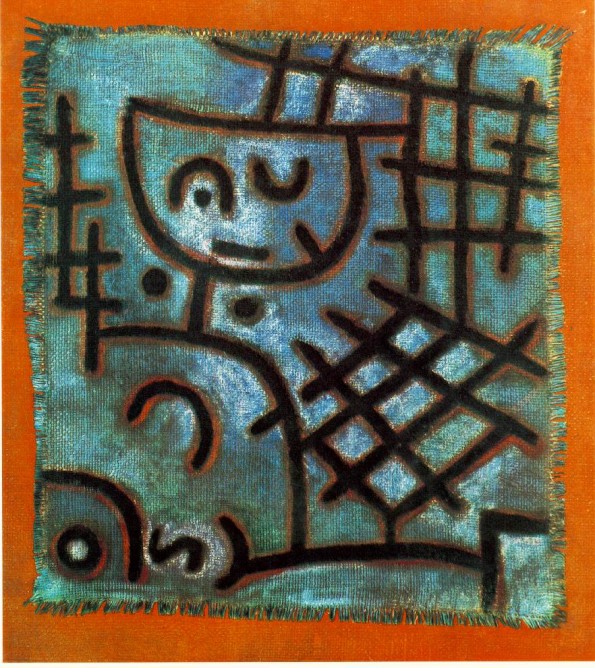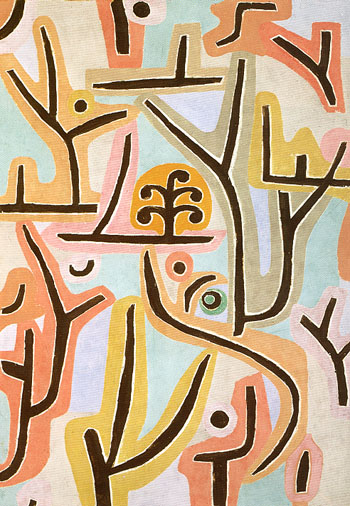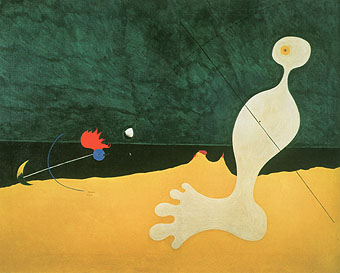Skip to comments.
After 66 years, Paul Klee's paintings finally find a permanent home
Santa Fe New Mexican, ^
| June 21, 2005
| UTA HARNISCHFEGER
Posted on 06/22/2005 12:13:34 AM PDT by nickcarraway
BERN, Switzerland - When Paul Klee applied for Swiss nationality after fleeing Nazi Germany, his request was refused because it was feared that if his art should "take root in Switzerland, it would insult real art and cause good taste to deteriorate."
Sixty-six years later, the work of the painter _ now considered one of the greatest modern artists _ has found a permanent home in Bern, the Swiss capital that finally accepted him. The Zentrum Paul Klee, which opens Monday, will house over 4,000 pieces of Klee's creations _ one of the world's largest collections from a single artist.
"This is a belated reconciliation (of Switzerland) with Klee," says the artist's 65-year old grandson, Alexander Klee, who calls himself "the most authentic Klee groupie around."
Klee was born in Bern in 1879 but had to take his German father's citizenship rather than his Swiss mother's under Switzerland's strict citizenship rules. He moved to Munich, Germany, to study art when he was 19 and lived most of the next 35 years in Germany. Soon after the Nazis came to power in 1933, Klee _ targeted for his "decadent" art _ returned to Switzerland and took refuge in Bern.
Adolf Hitler's regime confiscated Klee's abstract and expressionist works in German museums and stripped him of his teaching post at the Duesseldorf Academy. In 1936, he was diagnosed with incurable scleroderma, a chronic autoimmune disease. He applied for Swiss naturalization in 1939, about a year before his death, and never received it.
"This museum is much nicer than anything I would have ever dreamt of," says his grandson, who recalled growing up "thinking nothing special of all those pictures on the wall."
There were so many of his grandfather's paintings stored at his childhood home that they were hung in double rows and even behind doors, Alexander Klee told The Associated Press in an interview.
Alexander, who was born the year his grandfather died and who never met him, first proposed combining the family's private collections with Klee pictures in Bern's art museum, where they had been stored ever since a Bern businessman bought thousands of works in 1946 to prevent them from falling into the hands of the Allies under post-World War II compensation accords.
In 1997, Paul Klee's daughter-in-law, Livia Klee-Meyer (Alexander Klee's stepmother), donated her collection of paintings on the condition that Bern build a dedicated museum. She set a deadline for the museum to be finished by 2006.
The city had another stroke of luck when Maurice Mueller _ a world-famous orthopedist and the inventor of artificial hips _ and his wife, Martha, donated over ?50 million (US$60.6 million) to build the museum and a large piece of land on which to place it. To design the Zentrum Paul Klee, they worked with their friend Renzo Piano, the celebrated architect whose recent work includes Kansai airport in Osaka, Japan.
Inspired by the rolling hills surrounding the site, Piano imagined a massive landscape sculpture made of steel and glass that stretches over the length of one and a half soccer fields. It consists of three hills, or waves, and resembles a dinosaur's back. Piano said he wanted to give Klee's work "ample room to breathe."
Bordered by a highway on one side and the cemetery where Klee is buried on the other, the museum is a "green island and mysterious space," Piano says.
Inside the main exhibition, gauze has been stretched over the dividing screens. There are no closed rooms and no direct spotlights. The idea is that visitors should perceive the exhibition hall as a single room and move unhindered through the exhibit.
To pay tribute to Klee's wide-ranging interests _ teaching, playing the violin and writing poetry _ the museum also houses a music hall with 300 seats, a children's museum and room for workshops. The center will also be home to a summer academy for young artists, and children will offer guided tours to other youngsters.
In the permanent exhibit, visitors are immediately greeted by one of Klee's masterpieces "High Spirits," a 1939 oil and colored paste painting. Drawn with bold, black strokes, it depicts a stick man balancing on a tightrope with characteristic blotches of red and teal. The risky dance of the tightrope walker is a metaphor for Klee's own endangered artistic career, representing the twin threats of Nazi Germany and Klee's faltering strength.
"We wanted to make a very strong statement right at the beginning," Michael Baumgartner, a museum curator, says.
Around the corner is a rare sample from Klee's early career, a 1900 five-piece folding screen in art nouveau style, somewhat different from his other works. Following his return from the Munich art school, Klee drew the picture for his sister but later pledged "never to follow this path any more."
In 1914, Klee visited Tunisia with his friend, August Macke, a trip that became a key moment in 20th-century art history and inspired a series of watercolors that became a touchstone for the modern movement.
"Color has got hold of me, I no longer need to grasp it," Klee wrote in his diary.
The museum also shows hand puppets Klee made for his son, Felix, between 1916 and 1925. Assembled from odd materials ranging from beef bones to rabbit fur and matchboxes, the dolls look almost like assemblages, which at the time were the latest invention of the avant-garde movement of Pablo Picasso and Georges Braque.
There are also several square oil paintings with colored geometric shapes from the 1920s, when Klee became deeply involved with the Bauhaus, a hugely influential architectural and design movement that lasted from 1919 till 1933. As a teacher in Weimar and Dessau, Klee developed systematic theories on color.
In the early 1930s, he moved on to upbeat pointillist mosaics, whereby he spread colors across the surface as dots.
In "Tendril," from 1932, the plant strives upward to the light of the cosmos, symbolized by the sun, moon and stars _ characteristic elements in many of Klee's paintings. Klee, who liked experimenting with strange surfaces, made the sun as sand on wood.
While many artists' skills diminish with age, his grew stronger. As the illness took hold, his paintings changed; colors became bolder, formats became larger and lines stronger. During the last year of his life, Kless drew over 1,200 pictures.
TOPICS: Arts/Photography; Miscellaneous
KEYWORDS: art; klee; switzerland; wwii
Navigation: use the links below to view more comments.
first 1-20, 21-28 next last
To: nickcarraway
I thought he had a permanent exhibit in Munich. They have a great collection that I saw in the late seventies.
2
posted on
06/22/2005 12:27:24 AM PDT
by
lainde
To: nickcarraway

Klee Arab Song

Klee Captive

Klee Park near Lucerne
Thanks for the post. Klee loved a child-like quality in art, uncorrupted and free. His work can be characterized under Surrealism with its dream-like inspiration. I expect that there will be many comments that his work could be done by a child, and he wanted that quality to his work. However, there is a deceptive variety and sophistication to his style. For instance, in the Arab Song at the top, one can see references to Arab women as well as a window or even a cat.

Piano's plan for the Klee Museum.

Rogers and Piano's Pompidou or Beaubourg Museum in Paris. This is where all the modern art in Paris is located.
To: Sam Cree; Liz; Joe 6-pack; woofie; vannrox; giotto; iceskater; Conspiracy Guy; B Knotts; Dolphy; ...
Art ping.
Let Sam Cree or I know if you want on or off this list.
To: Republicanprofessor
Art Appreciation/Education ping. Let me know if you want on or off this list.
Our next "class" will be about Surrealism. Klee is not part of the Magic Surrealism (which included Dali and his "melting clocks"). Instead, he belongs to Biormophic Surrealism, which includes the work of Miro, and which deals with organic images coming from deep inside and which often don't bear much resemblance to external reality.


Dali Persistence of Memory and Miro Person Throwing a Stone at a Bird
To: Sam Cree; Liz; Joe 6-pack; woofie; vannrox; giotto; iceskater; Conspiracy Guy; B Knotts; Dolphy; ...
Now this is the real Art Appreciation/Education ping.
Let me know if you want on or off the list.
To: nickcarraway
Klee is one of my all time favorite artists.
7
posted on
06/22/2005 10:39:45 AM PDT
by
finnman69
(cum puella incedit minore medio corpore sub quo manifestus globus, inflammare animos)
To: nickcarraway
8
posted on
06/22/2005 10:40:25 AM PDT
by
Aquinasfan
(Isaiah 22:22, Rev 3:7, Mat 16:19)
To: Republicanprofessor
Don't forget some of Dali's post 1940 "classic" works.
To: Republicanprofessor
What gorgeous colors and vibrancy.
I wish I could paint like that.
To: aristotleman
This is just a small selection of his work. Hard to choose which to post.
To: Aquinasfan
These are paintings?Often Klee used watercolor on burlap, so that he got a rough but transparent effect.
To: finnman69
Klee is one of my all time favorite artists. I guess then it's time to visit Switzerland. You can let us know how the museum is, architecturally and aesthetically. Bring back some pictures we can post.
To: Republicanprofessor
Did he prime the burlap in any way, and how are the
colors preserved so well?
To: Republicanprofessor
How about a bit more on Biormophic Surrealism, before we move on to Surrealism?
15
posted on
06/22/2005 12:21:18 PM PDT
by
nuconvert
(No More Axis of Evil by Christmas ! TLR) [there's a lot of bad people in the pistachio business])
To: Republicanprofessor
Can we spend a bit more time on Miro? This work and some others reminds me of Kandinsky
Chiffres et Constellations

16
posted on
06/22/2005 12:29:08 PM PDT
by
nuconvert
(No More Axis of Evil by Christmas ! TLR) [there's a lot of bad people in the pistachio business])
To: nuconvert
Wow, are there a lot of hidden images in the Miro you posted. I'm still counting 'em. Don't know what they all are, though.
A couple of fish, a cat, a clown, hmmmm. What else?
Now, that's a happy piece of art one could put on the wall of one's rec room.
Leni
17
posted on
06/22/2005 3:01:14 PM PDT
by
MinuteGal
(Remember, Half the People You Know are Below Average)
To: finnman69
18
posted on
06/22/2005 3:48:11 PM PDT
by
stands2reason
(It's 2005, and two wrongs still don't make a right.)
To: nuconvert
Yeah, we should explore the Bauhaus modernists some more...
19
posted on
06/22/2005 3:49:51 PM PDT
by
stands2reason
(It's 2005, and two wrongs still don't make a right.)
To: MinuteGal; nuconvert
More time on Miro and Bauhaus; okay, here goes.
Miro actually began as a cubist, but then he evolved into a surrealist. He was Spanish, from Catalonia, as was Dali and Gaudi. I think there must have been some funny stuff in the water up there, because these could be seen as three of the strangest artists/architects in history. First, a cathedral by the architect Gaudi, who was working at the end of the 19th and beginning of the 20th century.

Gaudi Sacrada Familia Barcelona, Spain; one needs to see even more works by Gaudi to get a real image of his variety and imagination.
So Juan Miro (1893-1983) began working in the teens or so, and his early works are in a cubist vein. Then his Farm and Tilled Field become more abstract until we no longer recognize the cow, or dog, or barn or other images. The way that he combines the ladder and the eye, and other circus like imagery in Harlequin’s Carnival is what makes him Surreal, in the use of dream-like imagery. But because his imagery is more organic, rounded, imaginative and not as based in reality as Dali, he is seen as a Biormorphic Surrealist.

Miro The Village

Miro The Farm c. 1925 A footnote of interest is the Ernest Hemingway bought this painting soon after it was finished, I think for about $100. Do you see any aspects of Spain in here that we see also in his novels?

Miro The Tilled Field late 1920s

Miro Harlequin’s Carnival
I had an accountant who had prints of Miro’s work all over her office. I was surprised and asked what intrigued her. She responded that she appreciated the happy attitude, despite living through the horrors of two world wars and some personal tragedies, he was still upbeat in his work, as Leni also noted above. What is also fun is that I don’t see all the things that Leni sees in that other posted work by Miro, but that doesn’t matter. It is joyful and imaginative, and that’s what’s important. Each of us can see different things, and that’s fine.
BTW, Biomorphic Surrealism is just one branch of Surrealism. Some of these lines get a bit blurred when we get to the Bauhaus, where there may be more similarities in abstraction between Klee and Kandinsky than differences. Kandinsky's work at the Bauhaus became more theoretical and, some might say, a bit stiffer. The lines are much more hard-edged, and some miss the spontaneity of his earlier brushwork. But there is still life in these tighter works.
Here are some of his later Bauhaus works. Do you like them better or worse than his earlier ones, such as Composition IV, that were posted earlier (in http://www.freerepublic.com/focus/f-chat/1424087/posts)

Kandinsky Composition IV c. 1913

Kandinsky Composition 8 1920s-30s
Kandinsky was one of the first, if not the first, to actually write about abstraction in a rational, theoretical way. In Point and Line to Plane and Concerning the Spiritual in Art, he wrote about what effect certain colors and shapes had. He felt that yellow was like a triangle in harshness; but I feel that yellow creates a circle. (I am probably more trite in my perception, like a sun in early children’s works.) It doesn’t matter so much if we agree with him; what matters is that he was the first to think about abstraction like that.
The Bauhaus was probably the most influential school of design between the wars. It was set up in Weimar initially in 1919 by Walter Gropius and then moved to Dessau about 1923 with a new campus designed by Gropius. Great artists from all over Germany worked there: Josef Albers, Klee, and Kandinsky were just a few of them. They aimed to rebuild Germany with great architecture and design for all, including the lower and middle classes. It was closed by Hitler in 1933. Below: Gropius’ Dessau campus with the International style of architecture: sleek planes, metal and glass, with open studio spaces inside. This style of architecture echoed the flat planes of cubism, but in three dimensions.

Navigation: use the links below to view more comments.
first 1-20, 21-28 next last
Disclaimer:
Opinions posted on Free Republic are those of the individual
posters and do not necessarily represent the opinion of Free Republic or its
management. All materials posted herein are protected by copyright law and the
exemption for fair use of copyrighted works.
FreeRepublic.com is powered by software copyright 2000-2008 John Robinson















